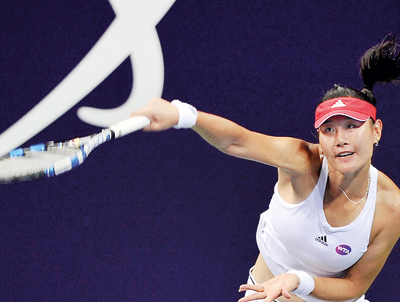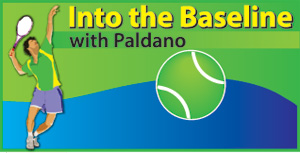Time to ask ‘Quo vadis?’ again
 China, in the last decade, has become Tennis Country. Right now, the world’s professional Tennis circuit is in China. Everything is there for another good WTA and ATP Chinese autumn season. It attracts the best of players, with good venues, appreciative spectators, excellent Chinese players and the rest. In Tennis, China is a success story. They have understood and navigated not so easy waters, well. One of the pitfalls in a nation’s Tennis is the ever so frightening dropout rate of players, around 17 years, from the game. This has to stop.
China, in the last decade, has become Tennis Country. Right now, the world’s professional Tennis circuit is in China. Everything is there for another good WTA and ATP Chinese autumn season. It attracts the best of players, with good venues, appreciative spectators, excellent Chinese players and the rest. In Tennis, China is a success story. They have understood and navigated not so easy waters, well. One of the pitfalls in a nation’s Tennis is the ever so frightening dropout rate of players, around 17 years, from the game. This has to stop.
A study
Social research to find as to what sport is in the world of today, for a person, is being done. Some interesting social sporting trends are seen. So far, no conclusions have been released. They want to know ‘why’ they exist. While sport in general is encouraged in all forms, without reservations, not all are being termed positive.
There are two main areas today in sport involvement. That is as ‘Activity’ and as ‘Competition Maturity’. There is also a long list of others involving sport. Some do not even take a person to the playing field. In High Performance, ages from 16 to 28 years is in purview. For this age group, Physical Development and Competition maturity are the two main areas that lead to a rewarding career.
A commodity?
Sport today has evolved into another market place commodity. This is the reality. This is the issue many countries have, in having an effective ‘Development-Programme’.
In the area of ‘Activity’, the children and adults only seek exposure to sport and to have an interest as a free-time activity. In High Performance, it is to play at competitive level, locally and internationally during the peak sporting span of life.
Both these need the same attention from the individual and from promoting bodies. Talking to overseas researchers whom I know, they did not want to commit to any conclusions. It is still under serious study. All of them detest sport being handled as a commodity. How else could it be done is still a riddle.
Walking Greek Statues
The physical contrast between players who do sport as Activity and as High Performance is unmistakable. One is black and the other is white. The sure sign of a High Performance athlete is the ‘Physical Presence’. Seeing Top 10 ranked Tennis player, can end up staring at their movements, ease of skills and performances for hours. Boris Becker of Germany and Gabriela Sabatini of Argentina were like walking Greek statues at Wimbledon. Their performing proficiency came from this build which got the best mental backing. Local and age group players of many countries cannot match the energy these good players projected.
Dropout rate
This is the concern that bothers all. Sport is an area where Skills, Physical Ability, good Health and good Lifestyle can be instilled in people. Keeping a person in sport is a critical aspect seen from all sides, regardless of age. None of the two researchers I spoke to were willing to commit themselves on the dropout rate, even with a percentage indication pertaining to a sport. They only indicate that, annually, over 10 million drop out globally, within a year or two in sport. This is from all sports, not only Tennis. The reason is, in my opinion, many fun designs are labelled as development designs. Nationally, in every nation, this leaves a question hanging. Who is fooling whom?
There are many ‘Activity based programmes’ in sport, while Development based programmes are virtually non-existent. This holds true even in developed countries. The demarcation between Activity and Development has become hazy. Often, High Performance is promised to attract customers, and what is delivered is ‘Activity’. Commercial squad formation is the culprit here. A very difficult area to escape.
Two roads and two goals
If national, continental and world class players is the goal of a programme, they cannot be produced through Activity oriented programmes after 16 years of age. Activity Tennis, according to an ex-Indian top ranker, is to keep kids off the road and homes free of nuisance. This is a very hard thing to say to people who send their children for Tennis lessons.
 The commitment to be a good player has to come from the players, to improve even after a bad loss, in age group Tennis around 16. Motivation is the magic word for this to happen. Watching good players motivate. Activity-Tennis commitments are weak that makes overseas events travel and participation to be tourist excursion. Only Development disciplines lead to Competition Maturity. The targets and the standards of these two are different.
The commitment to be a good player has to come from the players, to improve even after a bad loss, in age group Tennis around 16. Motivation is the magic word for this to happen. Watching good players motivate. Activity-Tennis commitments are weak that makes overseas events travel and participation to be tourist excursion. Only Development disciplines lead to Competition Maturity. The targets and the standards of these two are different.
A good approach for nations to ensure their elite players are not drowned in Activity-Tennis, is to bring international ranking into perspective. Then, competition perspective will slowly creep into the nations thinking. Many nations which have identified this issue, do their national ranking from WTA and ATP status.
In Colombo there were some globally recognised events. Delightfully, these have become an annual feature. In the past few years, our players’ performance in these is a repeat reminder of the missing road in our thinking. From what was seen this year, Competition-Maturity is the lesser trodden road.
George Paldano, Former int. player; Accredited Coach of German Federation; National coach Sri Lanka & Brunei, Davis-Cup, Federation Cup captain/coach– contact 94 77 544 8880 geodano2015@gmail.com –


